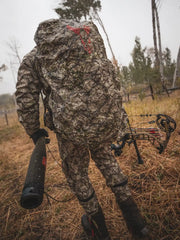August is finally here and that means we’re right around the corner from the start of hunting seasons.
If you’re like us, you spent the summer slinging arrows, poring over section maps and fine-tuning your gear loads. Later on, we’ll be at the range making sure our rifles and scopes haven’t had a falling out since last season.
Right now, however, it’s time to take a look at our treestands and make sure they’re ready to go opening morning.
Look, we get it, that sounds boring. But think about the amount of time that stand holds your butt up off the cold ground… way up off the ground. It’s your home away from home and plays no small part in the success of your hunt.
Trust us, you want a solid, well-maintained treestand under your tush.
Take Down and Inspect
If you have stands still up from last year, now’s the time to give ‘em some TLC.
First, you’re going to want to take down the stands and give them a once-over. It’s a hassle, but it’s also the best way to find problems before they require a doctor’s co-pay.
Check for rust, especially on the load bearing areas. Minor surface rust should be sanded off and a quick coat of camo paint reapplied. Major rust? It may be time to replace that stand.
Pay attention to bolts, screws, and anchors. If there’s any question at all, replace ‘em. It’s cheaper to buy a few bolts than to have screws put into your leg. And ratchet straps? We always swap out our straps for new ones every season. These are critical to keeping stands secure, so we just cover our bases. If they look good, throw them in the truck to strap down that new sofa you’ll be buying as a peace offering before the season starts.
Lastly, check your tree. Those things tend to grow, which can mess up even the best laid plans. Look it over from leaf to trunk, and be sure to check out the surrounding area, too. We moved a stand last season that sat near a creek. The heavy rains had eroded the bank to the point we opted to move it a few dozen feet further back (plus beavers were going to town on the trunk). A few months ago, we were tending to our trail cameras around that stand, and lo and behold we found that tree now laying across the creek. The bank had completely fallen away.
Location, Location, Location
Now that you have the stand down, cleaned up and rebuilt for another year, stop to consider if this is the right spot. Did you sit there freezing your butt to the seat and never see a single deer? Maybe you need to relocate.
Maybe the area has changed and you’re not in a good spot. Did a farmer take out a treeline in the spring, eliminating the bed down spots you used to rely on? Did a creek dry up, forcing the bucks to relocate? Did an emerald ash borer outbreak leave you with no backdrop or cover except some dead tree limbs? Don’t be afraid to move.
Reset, Test, Refine
Once you’ve chosen the spot to rule all spots, go ahead and reset the stand. After you have everything cinched down and secure, climb up and have a seat. Spend a while in the stand. Ask yourself, “Is this comfortable enough? Can I see where I need to see? Are there limbs or branches that need trimmed? How’s the data service up here?”
While you sit there, waiting for the next episode of “Become 1” to load, look for areas of refinement. What’s that mean? Are there metal-on-metal parts you can silence with a little strip of felt tape? Is the platform big enough for your size 15 clodhoppers? Where’s a good spot to mount the bow holder or camera?
Keep a list of these things if you aren’t prepared to make the upgrades on the spot. You have time, put it to use to make sure your time in the stand is as safe and comfortable as possible come whitetail season.
Oh, and since some of y’all still end up base jumping without a parachute, be sure to always wear your safety harness. Many of our jackets have the port so you can easily wear it under your gear. We made it easy, for Pete’s sake.
It’s not the most fun thing to wear, we get it. It’s like wearing the world’s worst underwear for a low-budget wire fighting student film.
The hot trend these days, and one we’re totally on board with, is the use of a safety line that goes all the way to the ground. Use a Prusick knot to attach your harness to this line and now you’re protected from the first rung of the ladder to the top of the stand.
No matter how uncomfortable it may seem, it’s still way cozier, easier on the skin and cheaper than a cast.
















